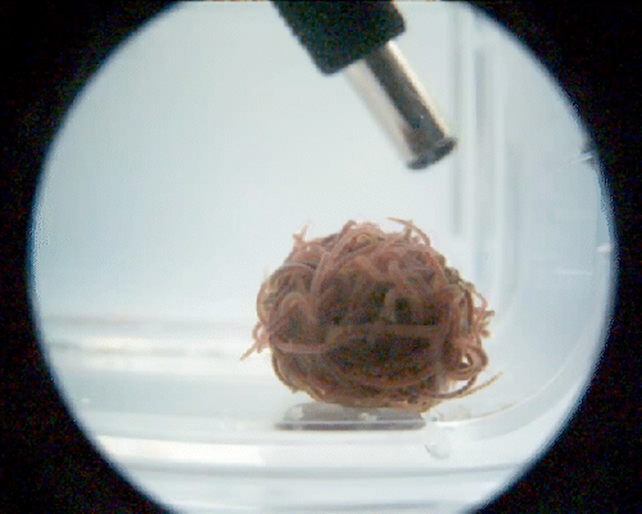Despite our talent for tying knots in everything from shoelaces to laser beams, we humans still have much to learn from a tiny, entanglement-prone worm.
Commonly known as California Blackworm, the tiny invertebrate Lumbriculus variegatus has graciously revealed some of its secrets in a new study examining the math behind its incredible living knots.
Researchers at the Georgia Institute of Technology in the US have been studying black worms for years, fascinated by their ability for ultra-fast movement and their collective behavior – namely how they form massive knots or “blobs” with thousands of worms that can also dissipate in milliseconds .
In the new study, researchers from Georgia Tech and the Massachusetts Institute of Technology used ultrasound to shed new light on worm blobs and reveal details that could inform the design of robots with similar abilities.
“We wanted to understand the exact mechanics behind how the worms change their movement dynamics to achieve tangles and ultra-fast unraveling,” says co-author Saad Bhamla, an assistant professor in Georgia Tech’s School of Chemical and Biomolecular Engineering.
“Also, these aren’t just typical threads like string, ethernet cables, or spaghetti — these are living, active tangles that are thrown off balance, adding an intriguing layer to the question,” he adds.
Feral black worms live in North America and Eurasia, where they inhabit shallow waters at the edges of ponds, lakes, and swamps, eating dead plants and microorganisms in the mud.
frameborder=”0″ allow=”accelerometer; autoplay; write clipboard; encrypted media; gyroscope; picture in picture; web-share” allowfullscreen>
Individuals are about 4 to 8 centimeters (1.5 to 3 in) in length, but they can also become intricately entangled, forming a living worm clump of up to 50,000 individuals.
Blobbing helps them survive harsh conditions like extreme temperatures or lack of water that would kill lone worms. A wormspot can behave like a solid or a liquid, research has found, even demonstrating collective decision-making.
And while the worms can spend several minutes weaving with each other, they can separate in just milliseconds.
“I was shocked when I shined a UV light on the worm spots and they exploded,” says Harry Tuazon, a bioengineer at George Tech, a graduate student in Bhamla’s lab.
“But to understand this complex and fascinating maneuver, I started conducting experiments with just a few worms.”

After bioengineer Vishal Patil (now at Stanford University) and his colleagues saw Tuazon’s videos of the worms rapidly spreading out of a blob, they jumped at the opportunity to team up and study them.
“Knots and tangles is a fascinating area where physics and mechanics meet very interesting mathematics,” says Patil. “These worms seemed like a good playground to study topological principles in systems composed of filaments.”
Patil noted in a video that one worm moved in a figure-eight pattern, a “helical gait” that has been known in black worms for decades. However, Patil wondered if the movement could also be part of the secret to ultra-fast blob resolution.
The researchers hoped to explain a wormspot mathematically by modeling how the worms tangle and spread, but they would need more data. And recording precise images of a blob’s structure proved difficult.
“Capturing the inner structure of a living worm patch was a real challenge,” says Tuazon. “We tried all sorts of imaging methods for months, including X-rays, confocal microscopy and tomography, but none of them gave us the real-time resolution we needed.”
Finally, the researchers found a technique that worked: ultrasound. They immobilized a clump of worms in non-toxic jelly and used a commercial ultrasound machine to peer inside.
Bhamla, Tuazon and other Georgia Tech researchers analyzed the resulting ultrasound videos and then recorded about 46,000 data points to help Patil and Dunkel study the mechanics and topology of wormspots.
They used this data to create a mathematical model for blackworm entanglement and disentanglement, predicting that each worm should intertwine with at least two others as they merge. It has also been suggested that spiral gaits are key to the rapid spreads.
The visualizations of their model match very well with actual videos of worms tangling and untangling, the researchers report, showing how the worms’ spiraling motions cause them to quickly become tangled in a way that establishes a quick-release mechanism that relies on similar movements based.
“What’s striking is that these convoluted structures are extremely complicated,” says Patil. “They are disordered and complex structures, but these living worm structures are able to manipulate these nodes for critical functions.”
Studying worm knots could have many practical applications, the researchers note, such as synthetic filaments or shape-shifting robots that can change their properties as needed.
“Imagine a soft, non-woven material made up of millions of thread-like filaments that can tangle and untangle on command, forming an intelligent adhesive bandage that forms during wound healing, or an intelligent filter material that changes pore topology to accommodate particles of different types Capturing size or chemical properties,” says Bhamla. “The possibilities are endless.”
The study was published in Science.
#Researchers #uncover #bizarre #math #ultrafast #worm #blobs




